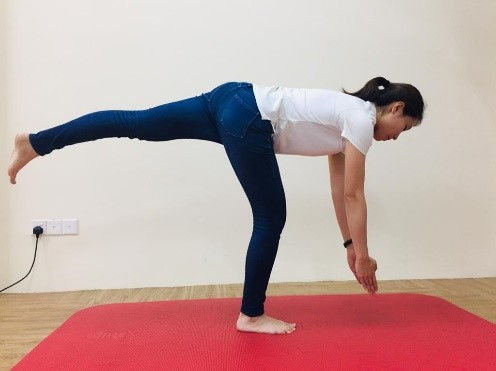Iliotibial Band Syndrome – Foam Rolling the only way?
- Crucial Rehab Team
- Oct 30, 2020
- 4 min read
The iliotibial band, or more fondly known as the IT band has been closely related to a lot of knee issues. Iliotibial band syndrome (ITBS) occurs in 5% to 14% of runners and is the leading cause of lateral knee pain and the second leading cause of overall knee pain in this population. The pain usually occurs at the side of the knee and can get really annoying especially if you are in the midst of training for a long distance run or happen to experience it halfway through your race.

The iliotibial band is not a muscle but rather a connective band that reinforces the longitudinal fibrous fascia latae that runs along the side of the thigh. It connects the side muscle groups of the hip notably the Tensor Fascia Latae (TFL) and Gluteus muscles. This allows the band to aid in the abduction, external rotation and extension of the hip and acts a lateral stabilizer of the knee.

Hence, it would be safe to say that tightness in the hip muscles whether due to a lack of stretching or as a result of weakness would also tighten the band. If observed closely at the insertion by the side of the knee, the band is allowed to move back and forth over the lateral epicondyle of the femur due to a lack of complete attachment. After enough repetitions via running or cycling, this irritates the band leading to inflammation. Pain is usually felt more prominently during heel strike and 30˚ of knee flexion.
What can be done?
FOAM ROLLING
Foam rolling has been increasingly gaining popularity in the fitness scene, especially among athletes in recent years. Many believe that it improves muscular performance and flexibility as well as alleviates muscle fatigue and soreness. This resonates closely with Wiewelhove et. al (2019)’s meta-analysis on the effects of foam rolling on performance and recovery. Pre-rolling during warm-up was found to provide short-term improvements in flexibility without affecting muscular performance for sprinters and post-rolling (recovery) was found to quicken recovery rate in elite athletes. Despite extensive research on the benefits of foam rolling, most studies were done on muscles that are somewhat “active” in nature as compared to fascia such as the IT band. According to a research by Macgregor et. al. (2018), it was found that there was no significant effect of foam rolling on the ITB among athletes in terms of hip adduction improvement thereafter. However, foam rolling the gluteus maximus muscle instead had significant results. This would agree with the facilitation of muscle relaxation / inhibition, which would occur to a greater degree in myofascial tissue than fascia alone.
With that being said, foam rolling the iliotibial band may have been a well-known method to resolve iliotibial band syndrome but it is not the only way. As mentioned before on how it is connected to the gluteus muscles and TFL, instead of putting yourself through so much pain of lying directly on your tense ITB, you may try gradually releasing your gluteus maximus/medius and TFL first before “attacking” your ITB.
ACTIVITY MODIFICATION
Prior to breaking down these myofascial adhesions, one needs to first manage the level of pain which can be done via training modifications to prevent further aggravations. This may include an ice or heat pack or decreasing the intensity of trainings. Some authors suggest complete rest for at least 3 weeks, some suggest up to 2 months. This highly depends on the level of severity which can be determined by a clinical practitioner.
STRETCHING
Just as how it works in foam rolling, stretching the ITB alone might not be as effective as also stretching the glutes. Here are ways to stretch both the ITB and gluteus muscles.
ITB stret
TTITB stretching #1


ITB stretching #2


Gluteus stretching


HIP ABDUCTOR / EXTERNAL ROTATOR STRENGTHENING
A study by Noehren et. al. (2014) has found that men with ITB syndrome exhibited greater hip internal rotation and knee adduction angles during the early stance phase of running. This was also accompanied by a reduced length of the ITB and diminished hip external rotation strength. A lack of hip abductor strength in cases of ITB syndrome was supported by Schreiber & Louw (2011). In the same article, it was found that after 6 weeks of gluteus medius training, there was an improvement in hip control and hence reduction of pain.
Basic- Straight Leg Raise in Side Lying


Clams


Hip Hiking


Advance- Single leg step downs


Single leg deadlift


In a nutshell, there are many ways to manage pain from ITB syndrome as well as to counteract this issue. Hence, before going straight into rolling out the ITB in future, remember the other “culprits” and try managing ITB syndrome more all-roundedly.
References
Hall, M., & Smith, J. C. (2018). The Effects Of An Acute Bout Of Foam Rolling On Hip Range Of Motion On Different Tissues. International Journal of Sports Physical Therapy, 13(4), 652–660. doi: 10.26603/ijspt20180652
Noehren, B., Schmitz, A., Hempel, R., Westlake, C., & Black, W. (2014). Assessment of Strength, Flexibility, and Running Mechanics in Men With Iliotibial Band Syndrome. Journal of Orthopaedic & Sports Physical Therapy, 44(3), 217–222. doi: 10.2519/jospt.2014.4991
Schreiber, R., & Louw, Q. (2011). The effect of gluteus medius training on hip kinematics in a runner with iliotibial band syndrome. South African Journal of Physiotherapy, 67(2). doi: 10.4102/sajp.v67i2.42
Wiewelhove, T., Döweling, A., Schneider, C., Hottenrott, L., Meyer, T., Kellmann, M., … Ferrauti, A. (2019). A Meta-Analysis of the Effects of Foam Rolling on Performance and Recovery. Frontiers in Physiology, 10. doi: 10.3389/fphys.2019.00376
Zemadanis, K., & Betsos, T. (2017). Short-Term Effects of Mobilization-with-Movement (MWM) and Auto-MWM Application in Recreational Runners with Iliotibial Band Syndrome. International Journal of Physiotherapy, 4(6). doi: 10.15621/ijphy/2017/v4i6/163919




Comments